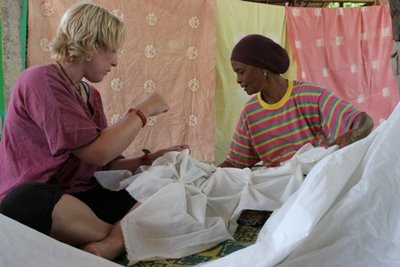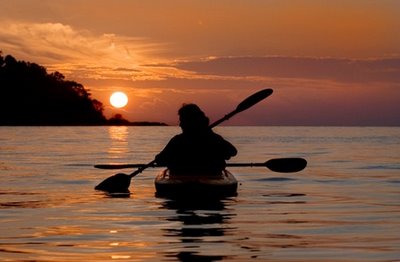


Issue 14: Eco Adventures
Jul / Aug 2006Lifestyle and Travel Magazine
Pictures courtesy of North Andaman Tsunami Relief
Before Jamie M. Johnston set off for Thailand, he and his wife researched possible destinations
using internet search keywords like ‘responsible travel’, ‘eco-friendly’ and ‘sustainable tourism’.
They knew that ecotourism has a lot of potential for developing countries that boast a broad range of unique and pristine natural features. They found a lot more than they bargained for.
Some of the first areas to develop ecotourism – such as Kenya, the Galapagos Islands and Thailand – have already greatly suffered from weak development controls and ever increasing numbers of tourists. My wife and I arrived in Bangkok pragmatic, yet hopeful for some real cultural and adventurous experiences.
After a spell up north, and a disappointing introduction to the south, we made our way to Khao Sok National Park, which in turn led us to the small town of Kuraburi – a popular rest stop for those heading to the Marine National Park of Koh Surin. From there we visited Golden Buddha Beach, an eco-resort with a resident Sea Turtle Conservation project on the stunning small island of Koh Phra Thong. We strolled hand in hand, along kilometre after kilometre of untouched, pristine, golden beach with a fiery red and orange sunset painting the distant rain clouds, not another tourist in sight – an experience that was becoming difficult to envision in southern Thailand.
But there we were also witness to the lingering effects of the devastating Indian Ocean tsunami. This was no popular tourist destination like Phuket or Khao Lak; there had been no large corporate-funded rapid rebuilding here.
Instead, almost a year later, there were still uprooted trees, half-standing buildings and debris everywhere. Despite that, Golden Buddha had dusted itself off and done its best to reopen the doors not washed away. The rain and unchecked view out across the Andaman Sea took on a more haunted quality.
Within minutes we had fallen in love with the area, to the degree that we decided to stay and teach English with the pioneering group, North Andaman Tsunami Relief (NATR): a grassroots organisation born out of Golden Buddha Beach by Bodhi Garrett, an employee who was home in America during the tsunami. He was moved to action when Koh Phra Thong and its neighbouring coastal villages were largely overlooked in the relief efforts.
Mustafa, a local guide, teacher and environmentalist told me how overblown the aid had been in terms of construction of boats and houses. As he so succinctly said, “You can’t put your name on education, but you can put your name on a boat or a house.”
At NATR, at which we are now volunteering, we quickly learned that all the qualities that had attracted us to the area could also be its undoing. With the cultural diversity of traditional Buddhist, Muslim and Moken communities living alongside one another, a largely undeveloped coastline, plenty of rare and abundant wildlife and some of the oldest jungle terrain in the world, the area is ripe for an ever-expanding tourism market. Yet as tourism becomes a more prominent economic force in the area, there is a danger of local communities being unprepared, both in terms of job skills and cultural resilience. This could lead to rapid community, and natural, degradation.
NATR works with the coastal communities of the Kuraburi and Suksamran Districts (Phang-Nga and Ranong provinces, respectively) to facilitate a long-term strategy for development. The difference is that “development”, when NATR uses the term, is about sustainable livelihoods, vocational training, education, and income-generating projects. NATR has also been exploring the potential of Community-Based Tourism (CBT) by setting up pilot homestay tours in the tsunami-affected villages they serve – a cultural exchange where tourists stay with a local family and participate in traditional forms of livelihood and custom. CBT ensures the community’s unique heritage isn’t degraded and, with the extra income from small numbers of visitors, is instead allowed to flourish.
So what can you expect on a CBT home-stay tour? Well, I had my first experience of one in the village Ban Pak Triam (population: 119). Their pre-tsunami village was on a peninsula surrounded by mangroves and accessible only by boat. After the waters of the tsunami washed right over it, sweeping all 50 homes away and claiming the lives of two children, the peninsula became a small deserted island. Now the village has been relocated to the mainland and is closer to the markets and schools – a trade-off the community seems largely happy with. Upon arrival we were greeted by our Muslim English-speaking guide, Mustafa, and the unique whooping sound of Gibbon calls from the surrounding jungle. Mustafa is not a resident of the village, but he possesses intimate knowledge of the community and, through translation, gave a voice to the villagers who followed our progress eagerly. He took us to our home-stay to meet the woman who had opened her doors for six strangers.
Ma Da, like the majority of residents, lives in a sparse and small two-storey house. The floors are tiled and pictures of the King adorn the walls. She explained, through Mustafa, that the village as a whole had accepted the idea of CBT but that only a minority was actively participating. She said CBT wasn’t the sole answer to providing for her family’s long-term future, but rather one more small way of eking a living alongside other means. All this reinforced the importance to us of how CBT ‘fits’ into the communities’ lives, not the other way round. Mustafa reminded us that livelihoods remain based upon traditional methods, such as cashew nut harvesting, fishing and rubber tapping. But the pressures of progress are having a detrimental effect. Intensive commercial fishing and large-scale shrimp farms are lowering fish stocks and driving market prices down. There is, in fact, very little economic diversity in the area and slowly, year by year, most of the young, talented people leave the village to find work in larger cities. Mustafa was keen to point out that CBT gives the villagers the opportunity to manage tourism on their own terms and, vitally, in their own time.
We were then led to the community centre where a group of women run a tie-dye collective. We participated in ‘tying’ the material with elastic bands to create the patterns and saw how the material is then boiled in natural dyes: rhododendron flowers for a light purple, and turmeric for a sharp yellow. From there, our itinerary said: ‘12pm to 2pm relax’ – so we did.
In the afternoon we high-tailed it on a long-tail boat with one of the local fishermen, known as Superman. Donning a mask and grabbing a spear he slipped into the water and splashed around to attract his prey, emerging victorious on more than one occasion. Mustafa explained he was diving to his traps. They had no float or means of locating them. Superman just remembered where they all were, and in this way they could not be stolen or tampered with.
We visited a krachang – floating fish farm – further inland amongst the mangroves. Each mesh tank became a frenzy of fins, teeth and writhing bodies when the farmer threw in scraps of food. He fattens red snapper, grouper, tarpon, barramundi and even a few lion fish for the markets and exports to places like Japan and Malaysia. Have I mentioned the food yet? At mealtimes, we were bombarded with sweetmilk curries, fresh seafood, eggs, organic vegetables and the obligatory white rice. (As this was a Muslim village, there was no alcohol or pork.)
For the grand finale we went back to sea with a larger crew for a few hours of night fishing. Blessed with a threequarters moon, twinkling stars and a fairly sedate swell we chatted, dropped our prawn-baited hooks and learnt quickly that there really is a method to line fishing. The next morning, before we were allowed to leave, we were given coffee, sticky rice, roti and Chinese doughnuts.
For now, NATR is facilitating the outreach for tourists to the villages. We’ve had individuals and entire families come and sample a multi-day tour of multiple villages. Our experience had us in agreement that for a successful CBT, you need a specific type of tourist – the ‘voluntourist’: one who wants to respect and observe customs and experience culture first hand. Long-term voluntourists may stay for weeks, enjoying the same fun activities but also taking part in community-based projects like day-care, English lessons and construction. But the truth is that NATR will only complete its work when it can withdraw fully from the various projects it has set up.
To faciliate this, NATR began a six-month training program last April for 25 carefully selected locals who are motivated to participate in vocational training focusing on Adventure-, Community-, and Eco- (ACE) tourism – the ACE Expert team. This core group will help to lay the foundations for successful community-driven tourism in their villages.
Trip Information:
Trips can be customised around various activities and any group size catered for. As well as the fishing, tie-dye and Krachang mentioned here, there are also opportunities to harvest and roast cashew-nuts, visit a Gibbon sanctuary, help in mangrove restoration, explore how natural rubber is made and participate in other handicraft ventures like card- or soap-making. For the adventurous, there are canoeing, trekking, biking and snorkelling opportunities. Generally, trips are three days long and the price – depending on activities but including food, accommodation, and transfers – for a group of four people, averages USD 38 (Baht 1,500) per person, per day, with an English speaking guide.
North Andaman Tsunami Relief
Tel: +66 (0) 1 787 7344
relieffund@inet.co.th
No comments:
Post a Comment